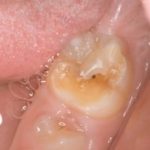
Molar incisor hypomineralisation (MIH) is a qualitative defect of enamel of systemic origin that can affect one or more first permanent molars and can also be associated with permanent incisors. The reported prevalence of MIH ranges between 2.4% to 40.6%. Teeth effected and prone to disease and prone to treatment failure.
The aim of this review was to evaluate systemic exposures associated with molar incisor hypomineralisation (MIH).
Methods
Searches were conducted in the Medline/ PubMed, Scopus, Web of Science, Latin American and Caribbean Health Sciences Literature database (LILACS), Brazilian Library in Dentistry (BBO) and Cochrane Library databases. Observational studies (cohort, cross‐sectional and case‐control studies) evaluating the association of prenatal, peri‐ natal and postnatal systemic factors with MIH were considered.
Three reviewers independently selected studies and extracted data. Risk of bias was assessed using the Newcastle-Ottawa Scale studies with 0‐3 points were considered to be at high risk of bias those with4‐6 points at moderate risk an those with ≥7 points at low risk. meta‐analysis included studies classified as having a moderate or low risk of bias considering exposures during the prenatal, perinatal and postnatal periods. random effects meta‐analysis was used to estimate the pooled odds ratio (OR) for the association between each systemic factor and MIH. Overall quality of evidence was assessed using Grading of Recommendations Assessment, Development and Evaluation (GRADE).
Results
- 29 studies (5 cohort, 9 case control, 15 cross-sectional) were included.
- Sample sizes varies from 45 to 4049 with a mean age of 9 years.
- 12 studies were considered to be at low risk of bias, 16 at moderate risk with one study at high risk.
- 26 studies contributed to the meta-analyses with a small number of exposures suggesting associations.
| No. of studies | Odds ratio (95% CI) | ||
| Pre-natal | |||
| Maternal medicine use | 6 | 1.10 (0.78‐1.54 ) | |
| Maternal smoking | 7 | 1.20 (0.98‐1.47) | |
| Maternal alcohol use | 2 | 1.16 (0.06‐21.6) | |
| Maternal illness | 14 | 1.40 (1.18‐1.65) * | |
| Psychological stress | 2 | 2.65 (1.52‐4.63) * | |
| Peri-natal | |||
| Caesarean delivery | 9 | 1.32 (1.11‐1.57) * | |
| Delivery complication | 5 | 2.06 (1.47‐2.88) * | |
| Prematurity | 12 | 1.22 (0.87‐1.70) | |
| Low birth weight | 10 | 1.52 (0.83‐2.79 ) | |
| Breastfeeding | 5 | 1.15 (0.95‐1.40) | |
| Post-natal | |||
| Respiratory diseases | 18 | 1.98 (1.45‐2.70) * | |
| Fever | 12 | 1.50 (1.22‐1.84) * | |
| Jaundice | 4 | 1.23 (0.73‐2.07) | |
| Infections | 15 | 1.47 (0.78‐2.76) | |
| Childhood illnesses | 12 | 1.42 (0.69‐2.91) | |
| Antibiotics exposure | 10 | 1.28 (0.99‐1.65) |
* Significant
Conclusions
The authors concluded: –
According to this systematic review, maternal illness, psychological stress, caesarean delivery, delivery complications, respiratory diseases, fever and childhood illnesses were significantly associated with MIH. However, as the evidence was gathered from studies with serious limitations, such as the risk of bias, imprecision and inconsistency, these results should be interpreted with caution.
Comments
We have previously looked at a review assessing potential aetiological factors for MIH (Dental Elf – 8th Sep 2017) The earlier review included 28 studies and suggested that early childhood illness (in particular fever) appeared to be associated with MIH. This new review has undertaken an extensive study including 29 studies. Of the included studies 10 studies are common to both reviews with 8 new studies published since the earlier review. The reviewers have chosen to look at 3 time periods, pre-, peri- and post-natal with the meta-analyses suggesting a number of possible associations during each of the time periods. However, the meta-analyses conducted included different study designs which present different quality of evidence and risks of bias. The authors were also concerned at the potential for publication bias with the tendency for studies showing significant associations being published. With only 12 out of the 29 studies being considered to be at low risk of bias the quality of the evidence is very low so this needs to be taken into consideration in interpreting the findings. High quality well reported prospective cohort studies that take into consideration and report potential confounders are needed to investigate risk factors for MIH.
Links
Primary Paper
Fatturi AL, Wambier LM, Chibinski AC, Assunção LRDS, Brancher JA, Reis A,Souza JF. A systematic review and meta-analysis of systemic exposure associated with molar incisor hypomineralization. Community Dent Oral Epidemiol. 2019 Oct;47(5):407-415. doi: 10.1111/cdoe.12467. Epub 2019 May 20. PubMed PMID:31111554.
Other references
Dental Elf – 2nd May 2017
Dental Elf – 8th Sep 2017
